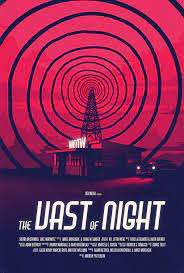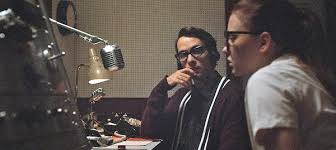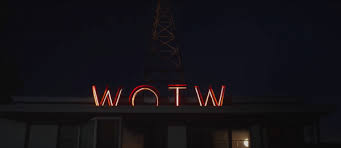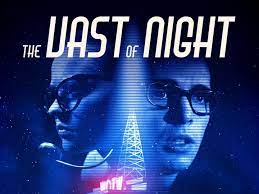The Vast of the Night (2019).
IMDb meta-data is a run time of 1 hour and 31 minutes, rated 6.7 by 43,000 cinematizens.
Genre: Sy Fy.
DNA: Roswell.
Verdict: A fresh twist on an old story.
Tagline: Watch the sky!

At a small crossroads town in New Mexico strange things are happening but most people don’t notice because they’re in the high school gym to watch the opening game of the basketball season against ArchRivals. Everyone, that is, except the all-night DJ on the local radio station and the high school girl who runs the town telephone switchboard until midnight.
This is the mid-1950s when only radio and telephone connected this remote town to the wider world.
This radio guy and this high school girl are both nerds and well aware of the fact that their jobs set them apart from others. Each sees the current alienation as an investment in bigger things to come. He aspires to a career in radio, elsewhere. She saves money to go away to college.
Establishing these backstories is done effortlessly but slowly, taking too much time on the clock. This Act I must take about 30 minutes.
Then, while alone at the little switchboard, she finds calls dropping out. Repeatedly. (I blamed Telecom!) Being of curious mind she starts monitoring calls and hears a strange sort of static before the drop. Being a nerd she happens to have a tape recorder (the size of a suitcase) at hand and records the static.
Since anyone she might ask about the static, like the day shift telephone operator, is at the game, she calls the radio station to consult the DJ and plays the static on the phone for him. ’Well, that is odd,’ is radio guy’s reaction. It is call-in radio and he gets a long meandering call about strange things from Bill. Then another from Mabel. (These two must be weirdos if they are not at the game, along with those callers whose connections were dropped.) Both Bill and Mabel, unbeknownst to each other, have each been long ostracised for their separate and independent reports of strange things, and welcome the chance to talk about their experiences. Radio guy and phone girl are good listeners. Much is hinted at but little is spoken. The hint is ‘Watch the Sky.’ This is Act II.

Pedants corner. Why he is not broadcasting the big game is anyone’s guess.
In Act III they rush around a lot, though I could not quite fathom why and she fetches a baby to carry around. Then they have their close encounter.
A great effort has gone into capturing the 1950’s with two-toned chromed, tail finned, and whitewall-tired cars, saddle shoes, cat’s-eye spectacles, poodle skirts, pocket protectors, yet the radio station has a ‘W’ call sign. ‘Impossible in New Mexico,’ cried the Fraternity Brothers. ‘West of the Mississippi was always “K.”’ But wait, WOTW might stand for the World of the Worlds radio broadcast. Belay that quibble.

Absent is the Red paranoia so palpable in those years. Bill and Mabel would have been suspected by some convoluted reasoning of being reds under their own beds.
Many of the lauding reviews focus on the technical aspects of camera work, length of takes, and other film school criteria that mean nothing to a viewer: me. What I want is a story and some characters to get to know. These characters remain distant from the viewer, I found, despite the close-ups. Oh hum.
Pick, pick, pick…even so, as it is, it is a far better thing than Asteroid City (2023) for all its millions.
For those who must know, the division between “W” and “K” for radio call signs was made as that medium expanded greatly in the 1930s. Prior to that “W” was the norm. When this regulation was introduced, stations west of the Mississippi that had used “W” were given the option to retain that heritage. Some did, others switched to “K.” Satisfied?
It has spawned a Podcast Series for the stans.

